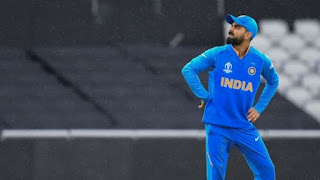1992 World Cup Semifinal match between South Africa vs England
To defeat England, South Africa was to score 22 runs in 13 balls. But then the rain falling from the sky stopped the game.
After 10 minutes when the rain stopped and the South African batsmen returned to the ground, they fired a new target on the scoreboard. 22 runs on a ball to win Although it was a typo and South African batsmen had to score 22 runs, 21 runs to win.
The new goal that was met by the rule of that time was shocking for everyone. Christopher Martin Jankis, who is commenting on the radio, said in a shocking voice, "I'm sure somebody will find a way out of this problem somewhere."
This commentary on the radio was also heard by a British statistician Frank Duckworth
In 1992, Duckworth had presented a paper in the Roy Statistical Society, whose title was - 'Fair play in bad weather.'
There was still a lot of work left in the way of making this paper a perfect rule. Tony Lewis, the lecturer of the University of the West of England, has made it difficult.
Both mathematicians gave the last form of rule through fax. The formula created with these two is called the Duckworth Lewis Rule.
After many attempts, the Via England Cricket Board found these rules to reach the ICC.
The first match with Duckworth Lewis rule
The Duckworth Lewis Rule was first implemented in 1997. The match was Zimbabwe versus England This match was won by Zimbabwe.
This rule was used in New Zealand, West Indies, India, Pakistan, and South Africa in 1998.
The ICC included the Duckworth-Lewis Rule in the World Cup in 1999. But then the weather in England was not like in 2019. As a result, these rules were not used in the 1999 World Cup.
The ICC adopted the Duckworth Lewis rule formally in 2001. It was used as a trial in all formats of cricket.
Duckworth Lewis rules permanently became part of the ICC in 2004. Although the rules have also been criticized.
After retiring Duckworth and Lewis, Professor Steve Stern was made its guardian. In 2014 this rule was renamed Duckworth Lewis Stern (DLS). To date, these rules have been used in more than 220 matches.
To defeat England, South Africa was to score 22 runs in 13 balls. But then the rain falling from the sky stopped the game.
After 10 minutes when the rain stopped and the South African batsmen returned to the ground, they fired a new target on the scoreboard. 22 runs on a ball to win Although it was a typo and South African batsmen had to score 22 runs, 21 runs to win.
The new goal that was met by the rule of that time was shocking for everyone. Christopher Martin Jankis, who is commenting on the radio, said in a shocking voice, "I'm sure somebody will find a way out of this problem somewhere."
This commentary on the radio was also heard by a British statistician Frank Duckworth
Duckworth told in a BBC interview, "I realized that it is a problem related to mathematics that needs to be addressed."
 |
| Frank Duckworth and Tony Lewis |
In 1992, Duckworth had presented a paper in the Roy Statistical Society, whose title was - 'Fair play in bad weather.'
There was still a lot of work left in the way of making this paper a perfect rule. Tony Lewis, the lecturer of the University of the West of England, has made it difficult.
Both mathematicians gave the last form of rule through fax. The formula created with these two is called the Duckworth Lewis Rule.
After many attempts, the Via England Cricket Board found these rules to reach the ICC.
Louise told the BBC, "It is so comforting to see that the players usually accept the decisions made by our rules now. Our rule in the development of the game has proved to be a lot of work. "
The first match with Duckworth Lewis rule
The Duckworth Lewis Rule was first implemented in 1997. The match was Zimbabwe versus England This match was won by Zimbabwe.
This rule was used in New Zealand, West Indies, India, Pakistan, and South Africa in 1998.
The ICC included the Duckworth-Lewis Rule in the World Cup in 1999. But then the weather in England was not like in 2019. As a result, these rules were not used in the 1999 World Cup.
The ICC adopted the Duckworth Lewis rule formally in 2001. It was used as a trial in all formats of cricket.
Duckworth Lewis rules permanently became part of the ICC in 2004. Although the rules have also been criticized.
After retiring Duckworth and Lewis, Professor Steve Stern was made its guardian. In 2014 this rule was renamed Duckworth Lewis Stern (DLS). To date, these rules have been used in more than 220 matches.





0 Comments